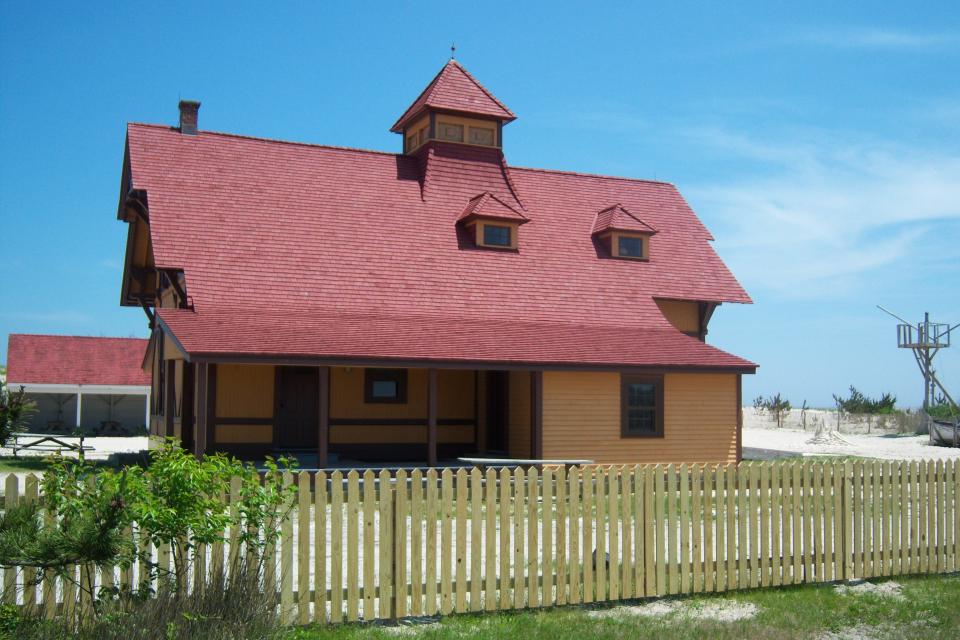Meet Martha Coston, international celebrity and developer of life-saving flare for sailors
- Oops!Something went wrong.Please try again later.
“Almost everybody in Washington recognizes the noticeable figure and face of Mrs. Martha (Jane) Coston whenever she appears in public places,” the Portland (Maine) Daily Press noted on April 8, 1892. “She has had a remarkable career, and her name is known in many countries.”
The surfmen of the Life-Saving Service in Delaware certainly knew the name “Coston,” but they may not have recognized Mrs. Coston if she had visited one of their stations.
Born in the 1830s, Martha was a tall, attractive teenager when she married Capt. Benjamin Franklin Coston, a young scientist and inventor who was in charge of the laboratory in the Washington Navy Yard. Benjamin’s work gave the young couple an entrance into Washington’s elite, where they hobnobbed with the likes of Dolly Madison, Daniel Webster and Henry Clay.
In 1848, Benjamin was wrestling with the problem of communications at sea, when he suddenly took ill and died. Martha was only 21 years old and the mother of four children. Benjamin’s death was quickly followed by the death of one of the couple’s young children, and shortly after this calamity, Martha’s mother also passed away.
Alone and without means to support herself, she recalled, “I knew not how to dig, I was ashamed to beg.”
On a rainy day, Coston was going through her late husband’s papers when she stumbled upon one of his unfinished projects: “At last I came upon a large envelope containing papers and a skillfully drawn plan of signals to be used at sea, at night, for the same purposes of communication that flags are used by day.”
Fires were the only way to communicate at night. On nights when rain drenched the Delaware coast, lighting a fire quickly was nearly an impossible task. In the early 19th century, the most reliable way of starting a fire was to strike a piece of steel with a flint and catch the resulting sparks in a nest of thin kindling.
Using her late husband’s notes, and with the help of civilian chemists, Martha began a decade-long quest, to develop a set of signal flares that were easy to use, portable and dependable.

By 1859, she had perfected a self-contained flare that was activated by a plunger that stuck a charge, which, in turn, ignited brightly-burning chemicals to provide a strong, steady light. An assortment of chemicals produced flares of different colors, and the color combinations were keyed to a codebook with a large variety of messages.
After perfecting her system of signal flares, Coston established a company that manufactured the flares and sold them throughout the world. When she traveled abroad to promote her company, she was introduced to many European leaders, including England’s Queen Victoria.
After the United States Life-Saving Service was established in 1878, a series of stations were eventually built at Lewes, Cape Henlopen, Rehoboth Beach, Indian River Inlet, Bethany Beach and Fenwick Island. The Life-Saving surfmen were issued a set of Coston flares, which they carried with them while they were on patrol.

When a surfman spotted a ship that was sailing too close to shore, he would ignite a flare to warn those on the ship to change course. If he saw a vessel that had run aground, the surfman would use his flares to signal that help was on the way.
Over the years, the use of Coston flares saved countless lives, but few people knew that they were developed by the international celebrity, Martha Coston, who once said, “I knew not how to dig, I was ashamed to beg.”
DELAWARE HUMOR: Exposing coastal secrets: Bathroom pavilions, beer hopping and pet preferences
DELAWARE HISTORY: How 'Three-Gun' Wilson led Prohibition fight against bootleggers and jellyfish officials
Principal sources
Topeka State Journal, Jan. 25, 1902
Arizona Republican, Sept. 9, 1893
Portland [Maine} Daily Press, April, 8, 1892
New York Tribune, Jan. 16, 1904
Coston, Martha, A Signal Success, Philadelphia: J. B. Lippincott Co., 1886,pp. 37, 40, 43-44.
This article originally appeared on Salisbury Daily Times: How Martha Coston developed life-saving flares for sailors in distress

